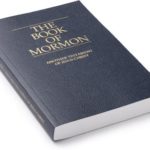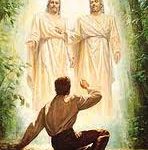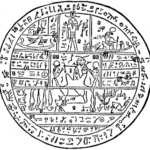 The Mormon God has evolved with the thinking of Mormon leaders. The Book of Mormon, the earliest Mormon text, insists there is one God. In a discussion between two characters named Amulek and Zeezrom we read:
The Mormon God has evolved with the thinking of Mormon leaders. The Book of Mormon, the earliest Mormon text, insists there is one God. In a discussion between two characters named Amulek and Zeezrom we read:
‘And Zeezrom said unto him: Thou sayest there is a true and living God?
And Amulek said: Yea, there is a true and living God.
And Zeezrom said: Is there more than one God?
And he answered, No.’
(Alma 11:26-29)
In conversations with Mormons this is a helpful text. The question is at the bottom of page 235 while the answer is over the page. Asking a Mormon what answer he or she thinks Amulek gives before turning the page can make for an interesting exchange.
On a time-line this teaching comes in March 1830, the date of the Book of Mormon’s publication. This ‘one God’ sounds singularly Trinitarian in nature, although is probably modalist in Smith’s mind:
‘..And the honor be to the Father, and to the Son, and to the Holy Ghost, which is one God. Amen.’
(Testimony of the three witnesses at the front of the book)
‘…And now, behold, this is the doctrine of Christ, and the only and true doctrine of the Father, and of the Son, and of the Holy Ghost, which is one God, without end. Amen.’ (2 Nephi 31:21)
‘The Father, because he was conceived by the power of God; and the Son, because of the flesh; thus becoming the Father and Son–And they are one God, yea, the very Eternal Father of heaven and of earth. And thus the flesh becoming subject to the Spirit, or the Son to the Father, being one God.’ (Mosiah 15:3-5)
In April of 1830 Joseph Smith produced Section 20 of the Doctrine and Covenants, which explains the organising of the Mormon Church, its officers, and members. We read there:
‘Which Father, Son, and Holy Ghost are one God, infinite and eternal, without end. Amen.’ (20:28)
By April 7 1844, three months before his death at age 38, Joseph Smith preached a very different God at the funeral of a Mormon elder named King Follett. This has come to be known as the King Follett Discourse.
‘God himself was once as we are now, and is an exalted man, and sits enthroned in yonder heavens! That is the great secret. If the veil were rent today, and the great God who holds this world in its orbit, and who upholds all worlds and all things by His power, was to make himself visible—I say, if you were to see him today, you would see him like a man in form—like yourselves in all the person, image, and very form as a man; for Adam was created in the very fashion, image and likeness of God, and received instruction from, and walked, talked and conversed with Him, as  one man talks and communes with another…
one man talks and communes with another…
I am going to tell you how God came to be God. We have imagined and supposed that God was God from all eternity. I will refute that idea, and take away the veil, so that you may see.
These ideas are incomprehensible to some, but they are simple. It is the first principle of the gospel to know for a certainty the character of God, and to know that we may converse with Him as one man converses with another, and that He was once a man like us; yea, that God himself, the Father of us all, dwelt on an earth, the same as Jesus Christ Himself did; and I will show it from the Bible.’
- In that same sermon he teaches that men may become gods, ‘Here, then, is eternal life—to know the only wise and true God; and you have got to learn how to be gods yourselves, and to be kings and priests to God, the same as all gods have done before you…’
Joseph Smith’s First Vision account was not widely known until 1840. It is interesting to note that Smith’s conception of God as told in this account appears to read back into and change his earlier teaching about the nature of the Mormon God.
- Brigham Young took up this same teaching, as did those who came with and after him. In his book Mormon Doctrine McConkie writes:
- ‘GODHOOD: That exaltation which the saints of all ages have so devoutly sought is godhood itself. Godhood is to have the character, possess the attributes, and enjoy the perfections which the Father has. It is to do what he does, have the powers resident in him, and live as he lives, having eternal increase. (D&C 132:17-20,37)’
- Fifth LDS president Lorenzo Snow (1814-1901) summed up this teaching in a famous couplet:
- ‘As man is, God once was
- As God is, man may become.’
- In the 4th June 1997 edition of Time magazine, the then church president Gordon B Hinckley, asked about this teaching about the Mormon God, replied:
- ‘I don’t know that we teach it. I don’t know that we emphasize it. I haven’t heard it discussed for a long time in public discourse. I don’t know. I don’t know all the circumstances under which that statement was made. I understand the philosophical background behind it. But I don’t know a lot about it and I don’t know that others know a lot about it.’
- Mormonism has moved from a triune, possibly a modalist God, through an exalted man, and men becoming gods, to the vagueness of Gordon B Hinckley. Mormons today are more nuanced in their understanding of the Mormon God, aided by a misunderstanding of the writings of C S Lewis, notably his Mere Christianity. Lewis’ view is biblical in that we are made in the likeness of God and are to be co-regent with him in ruling the earth; gods (Gen.1:26) He makes a clear distinction between the only begotten Son of God and the created sons of God. Mormons have blurred this such that they can see their own peculiar theology reflected in Lewis, doing him a great disservice. The typical Mormon view is still that we will be gods in the sense of being able to create our own spirit children who will have the same relationship to us as we do to our Father in Heaven.
If You Could Hie to Kolob
 There is a Mormon hymn with the words:
There is a Mormon hymn with the words:
If you could hie to Kolob
In the twinkling of an eye,
And then continue onward
With that same speed to fly,
Do you think that you could ever,
Through all eternity,
Find out the generation
Where Gods began to be?
- Kolob, in Mormonism, is believed to be the heavenly body closest to the throne of God. According to this hymn, the Mormon God is one in a pantheon going back through eternity, with no uncreated creator at the beginning of this procession of deities. Indeed, the process itself is what is eternal.
- Like gods before him, The Mormon God has a physical body and is an exalted man living on a specific planet, which brings him within the compass of creation. He cannot be the unchangeable eternal God of the Bible since he is a man who became God, ‘as all gods have done before [him].’
- Like the God of Jehovah’s Witnesses, the Mormon God is channelled through a hierarchy, an organisation, with tiers of offices, titles and ‘authority.’ This is no better illustrated than in the opening dialogue in the temple endowment film:
- ELOHIM: Jehovah, Michael, see: yonder is matter unorganized, go ye down and organize it into a world like unto the other worlds we have hereunto formed. Call your labors the First Day, and bring me word.
JEHOVAH: It shall be done Elohim. Come Michael, let us go down.
MICHAEL: We will go down, Jehovah.
JEHOVAH: Michael, see: here is matter unorganized. We will organize it into a world like unto other worlds we have heretofore formed. We will call our labors the First Day, and return and report.
MICHAEL: We will return and report our labors of the First Day, Jehovah.
JEHOVAH: Elohim, we have done as thou hast commanded, and have called our labors the First Day.
ELOHIM: It is well.
-
The God of the Bible
- The knowledge of God written about by Paul in Romans 1 comes to us by observation of our world and by our own consciousness of right and wrong. The arguments from design and from conscience are strong sources today for knowledge of God. Added to this is the self-revelation of God in history and the understanding of God’s activities among men through Scripture.
- Unlike the God of Greek philosophy and the gods of nature religions, the God of the Bible is an eternally living God. Man’s growing knowledge of him comes from his encounter with this living God and not from an organisation that doles out knowledge piecemeal.
- A Christian convert has all this experience of and teaching about God to draw upon and to inform their own journey of faith into the living God of the Bible. The Mormon convert has only the changing legacy of Mormonism’s much more recent history to draw upon in their journey of faith.
-
God is Omniscient
- The Mormon hymn If I Could Hie to Kolob includes the words:
- Do you think that you could ever,
Through all eternity,
Find out the generation
Where Gods began to be?
- Clearly there are limits to what may be known and understood, even by God, in Mormonism.
- Yet the Bible says, ‘God is greater than our hearts, and he knows everything.’ (1 John 3:20) Paul writes, ‘The Spirit searches everything, even the depths of God…no one comprehends the thoughts of God except the Spirit of God.’ (1 Cor5.2:10-11). John again writes, ‘God is light; in him there is no darkness at all.’ (1 John 1:5). God’s knowledge is so complete that he fully knows his infinite self.
- David writes, ‘O LORD, you have searched me and known me! You know when I sit down and when I rise up; you discern my thoughts from afar…even before a word is on my tongue, lo, O LORD, you know it altogether.’ (Ps.139:1-2, 4) The Christian God is omniscient, knowing all things.
-
God is Omnipresent
The Psalmist wrote:
Where can I go from your presence?
If I go up to the heavens, you are there;
If I make my bed in the depths, you are there.
If I rise on the wings of dawn,
If I settle on the far side of the sea,
even there your hand will guide me,
your right hand will hold me fast.
If I say, ‘Surely the darkness will hide me,
and the light become night around me,’
even the darkness will not be dark to you;
the night will shine like the day,
for darkness is light with you. (Ps.139:7-12)
How can this be true if God is a physical being, located in one place and working through agents and intermediaries? The picture of God in the heads of most Mormons does not allow for his omnipresence.
Jesus said of the believer, ‘If anyone loves me, he will obey my teaching. My Father will love him, and we will come to him and make our home with him.’ (John 14:23) How can this be if God is a physical being and ‘sits enthroned in yonder heavens?’
It is clear from what the Psalmist tells us that God fills the whole universe, and from Jesus’ words we may conclude he dwells in our hearts. In other words, the God of the Bible is omnipresent, an idea that was mocked mercilessly in the pre-1990 Mormon temple film.
God is Omnipotent
The rhetorical question put to Abraham was, ‘Is anything too hard for the LORD?’ (Gen.18:14) and Jeremiah plainly answers, ‘Sovereign LORD, you have made the heavens and the earth by your great power and outstretched arm. Nothing is too hard for you.’ (Jer.32:17) To Mary the angel said, ‘With God nothing is impossible,’ (Luke. 1:37) and it was Jesus who said, ‘With God all things are possible.’ (Mt.19:26) The God of the Bible is omnipotent and able to do anything that is logically possible and in line with his own perfect character.
These cannot be true of the Mormon God since he cannot, as a physical being, be omnipresent, nor can he be omniscient because even he apparently cannot, Find out the generation Where Gods began to be? The Mormon God is a contingent God, subject himself, to the Plan of Salvation of the Mormon Church, becoming God according to a plan that existed long before ‘God became God.’ Indeed, it is the plan that is eternal and not the Mormon God.
The Mormon God is, in fact, a created being, an exalted man. In Mormonism matter is eternal (as seen from the brief dialogue from the temple film) and spirit is eternal in the same way. When matter and spirit are put together you have a physical creature, a created being. This is the Mormon God, who is an eternal spirit but that spirit is not eternally God.


 There is a Mormon hymn with the words:
There is a Mormon hymn with the words: